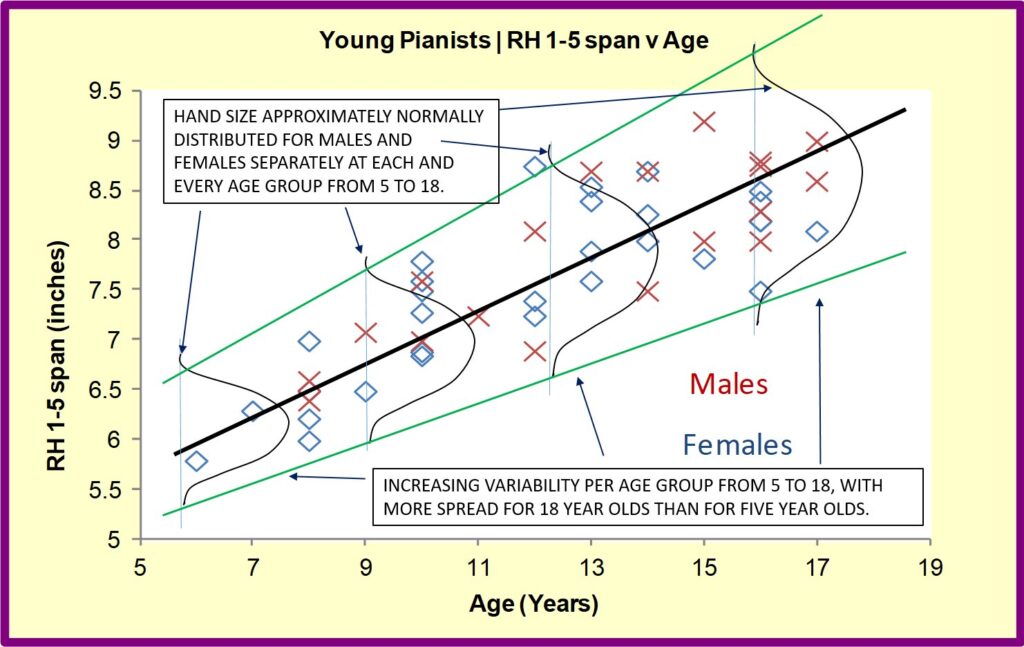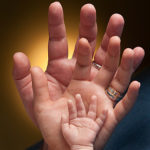Australian survey of pianists' hand spans
A recent study of mostly Australian pianists collected hand span and other data. The results are described in a paper by Boyle, Boyle & Booker published in December 2015 by the Australasian Piano Pedagogy Conference https://appca.com.au/proceedings/proceedings.html
Some key results are presented below. You can also download a summary document: https://paskpiano.org/wp-content/uploads/2021/09/NCKP-Hand-span-data-Statistics-Summary-2015.pdf. The analysis of hand span data from 473 adult pianists includes estimates of gender and ethnic differences, hand span versus a pianist’s ‘level of acclaim’, and comparison with a separate study of university students undertaking business courses (i.e. mostly non-pianists). Results have also been compared with previous studies of pianists and non-pianists. See Earlier hand span studies
Two hand span measures were collected – thumb to fifth finger (1-5) and second to fifth finger (2-5) active spans (maximum flat hand stretch) for both hands. For further explanation about taking hand span measurements, see: Measuring hand spans
Gender differences
Data from the Australian study shown here confirm earlier research: on average, the hand spans of adult male (thumb to fifth finger) are about one inch (or 2.5 centimetres) greater than those of adult females. This means men can reach, on average, more than one extra white key on the current keyboard.
The chart below illustrates the marked gender difference in 1-5 spans. From this study, the mean 1-5 span for males is 8.9 inches (22.6 cm) and for females, 7.9 inches (20.1 cm), a difference which is statistically significant at the 5% level. The taller peak on the left reflects the higher proportion of female pianists in the sample; the male to female ratio was about 2:1.
One can also see that only a very small proportion of males (2% in this study) have a span less than the female average, and that a similarly small proportion of females (2.9%) have a span larger than the male average. The tables underneath provide some basic summary measures for both 1-5 and 2-5 spans. The gender difference of approximately 0.5 inches in 2-5 spans is also statistically significant.
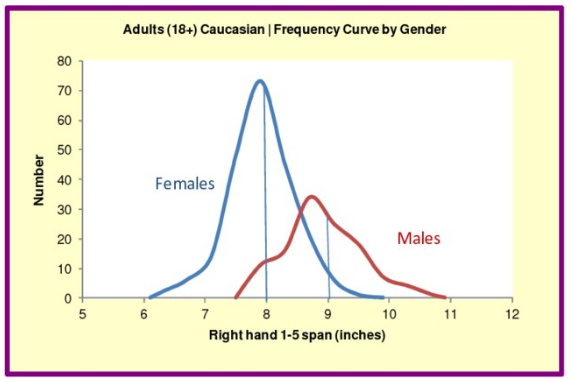
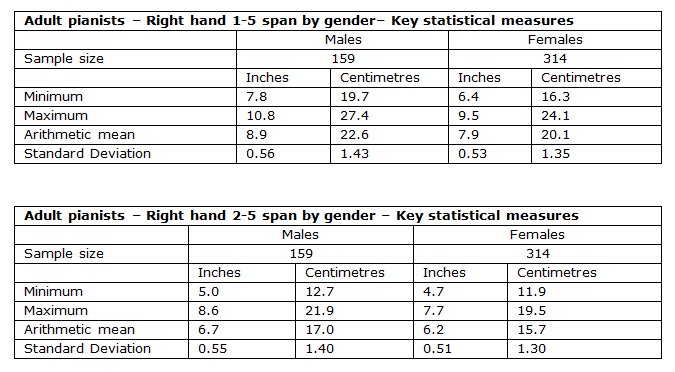
Ethnic differences
This is the first known study to analyse ethnic differences in pianists’ hand spans. Out of the 473 pianists in the Australian study, 456 were categorised as being of either Asian or Caucasian origin; the remaining 17 of mixed or other descent were omitted from this analysis. The tables below summarise the results for 1-5 spans. Based on this survey, Caucasian male spans are 0.3 inches larger than those of Asian males, and Caucasian female spans are 0.2 inches greater than those of Asian females. Analysis of 2-5 spans shows no statistically significant ethnic difference for males nor for females.
It is worth noting that based on this study, this ethnic difference in 1-5 spans (approximately one quarter of an inch) is much less than the overall gender difference of one inch. When Caucasians and Asians are analysed separately, the same gender difference is apparent. All 1-5 span ethnic differences are statistically significant.
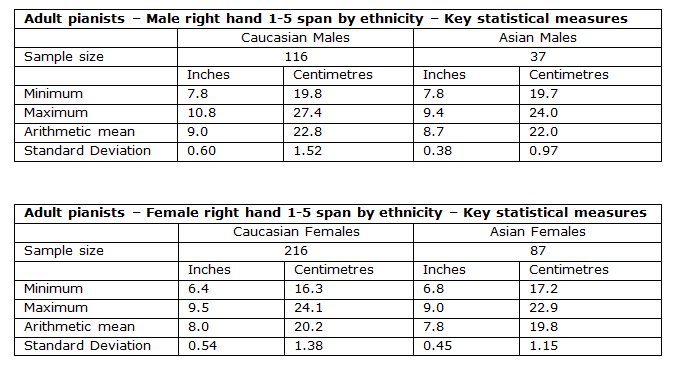
Hand span versus 'Level of acclaim'
Pianists in the Australian survey were classified according to ‘level of acclaim’ based on their success as a performer. There are 12 pianists with an ‘International’ profile (including some visiting performers from other countries) based on a successful long-term solo performing career across a wide range of repertoire, and/or success in major international competitions. A further 51 with a ‘National’ profile were identified on the basis of long-term performing careers mainly in their home country either as soloists (not necessarily across such a wide range of repertoire), chamber musicians or accompanists, and/or success in significant national competitions. All remaining pianists were classed as ‘Regional/Amateur’.
Below is a plot of active 1-5 right hand span measurements of all the adult pianists in the Australian survey, similar to that produced by David Steinbuhler in 2004. (See Earlier hand span studies.) As well as highlighting the gender difference, it shows those pianists of ‘International’ and ‘National’ acclaim. It indicates that all the ‘Internationals’ had spans of 8.8 inches or above, and that very few ‘Nationals’ had spans below the female average of 7.9 inches. To understand the impact of hand span on winners of international piano competitions, based on gender balance, see: Gender differences in major competitions and performing careers
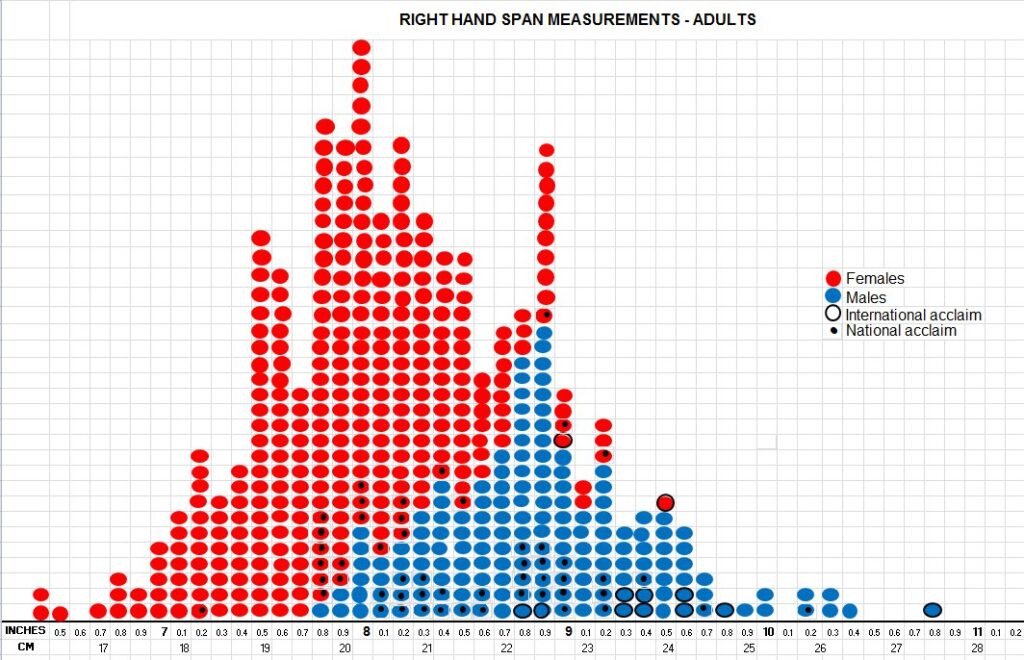
This table summarises the hand spans of these three ‘level of acclaim’ groups. The differences are statistically significant at the 5% level. Significant differences are also apparent when looking at 2-5 spans.

Looking at gender differences, the chart below compares the relative proportions of males and females in each of the three ‘level of acclaim’ groups. Note that the proportions are calculated as follows, taking International females as an example: (IF/TF)/(IF/TF + IM/TM) = 9.2 %, where IF = international females, TF = total females, IM = International males, and TM = total males.

A simpler way of looking at this ‘level of acclaim’ data by gender is to show the proportions of males vs females within each ‘level of acclaim’ group. Thus, using the same example as above, international females, the chart below shows IF/(IF + IM) = 16.7%. Unlike the first chart, this does not take into account the total number of pianists, male and female, in the study.

Children's hand spans
This same Australian study collected hand span data from 49 children and teenagers aged between 6 and 17 years. As can be seen from the graph, their 1-5 hand spans covered a wide range, from 5.8 inches (14.7 cm) to 9.2 inches (23.4 cm). Predictably, the older children tended to have bigger spans. This small sample also indicates another pattern one would expect, that is, increasing variability in hand spans as one moves up the age levels. Hand spans for each age group would most likely be approximately normally distributed if separated into girls and boys.
The study indicates that there is a significant overlap between the spans of adult women and those of young children (under 12 years). In other words, a significant proportion of women (almost one third) have ‘child-sized’ hands.
